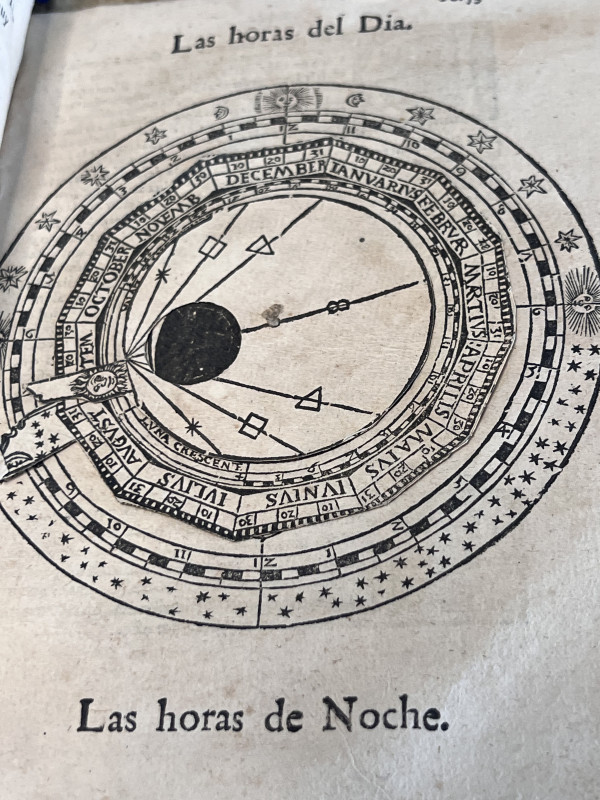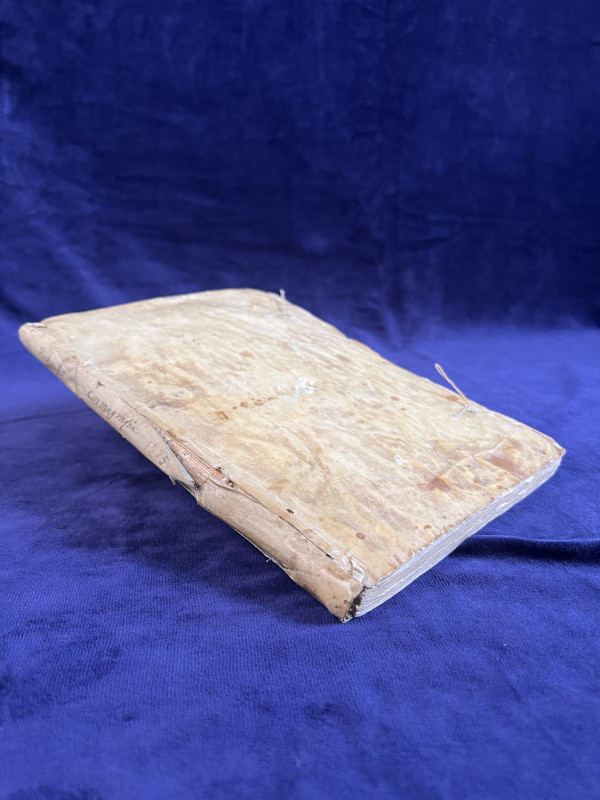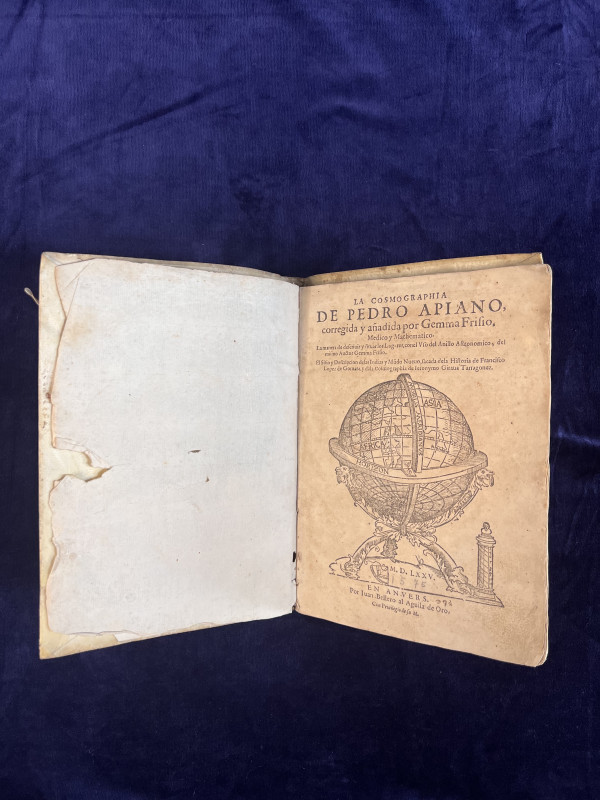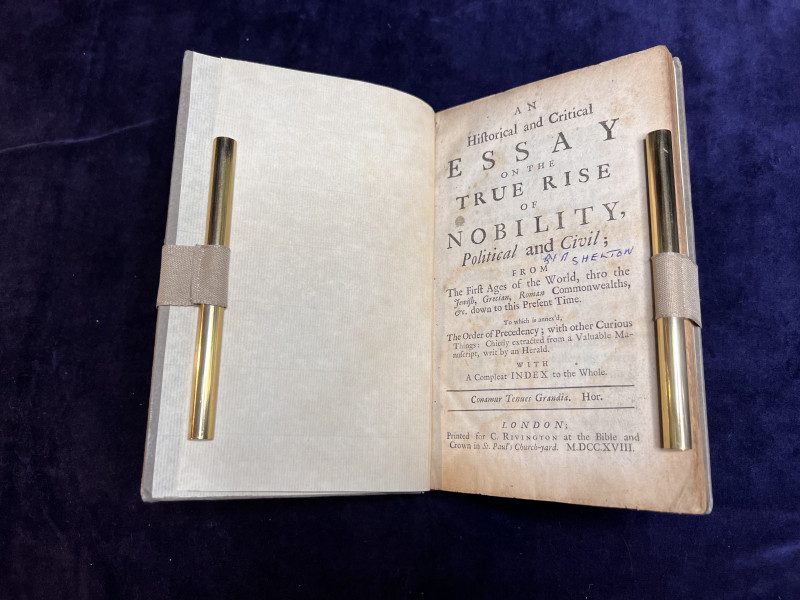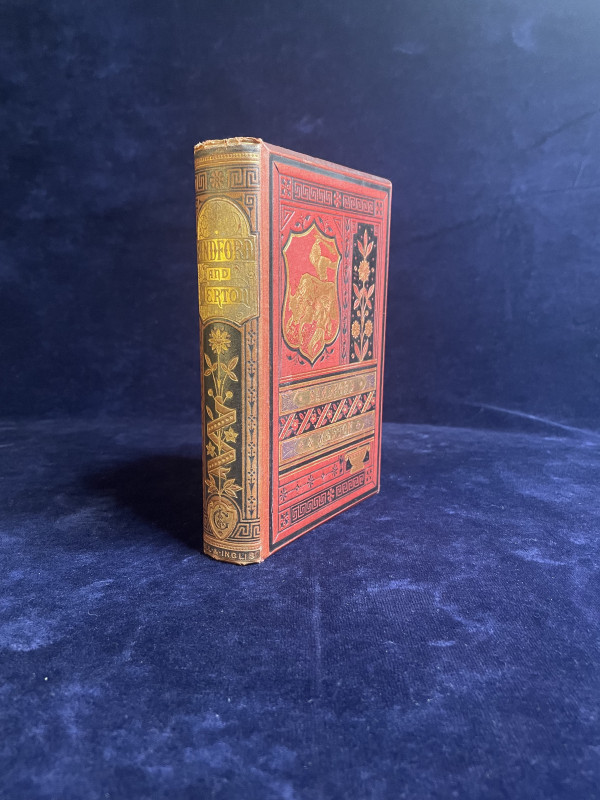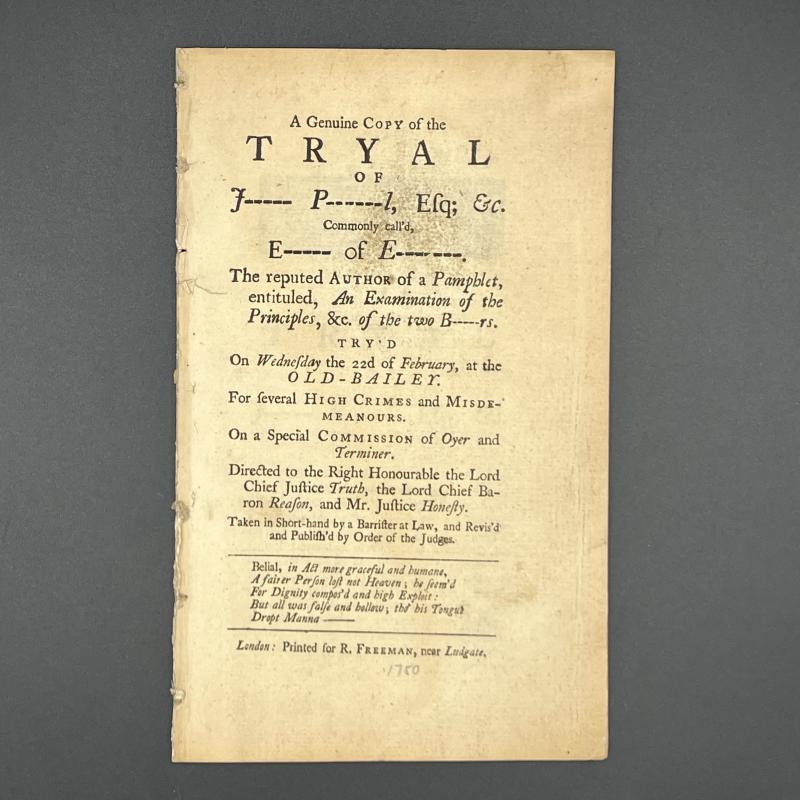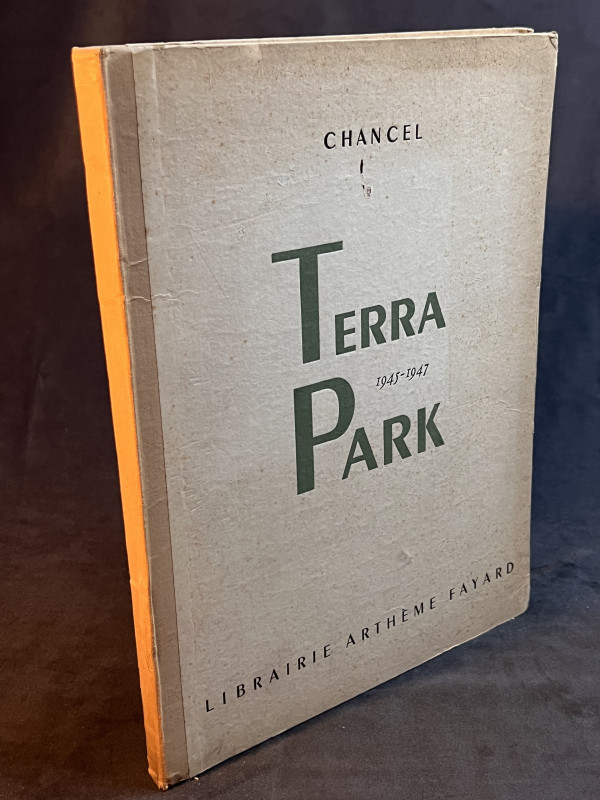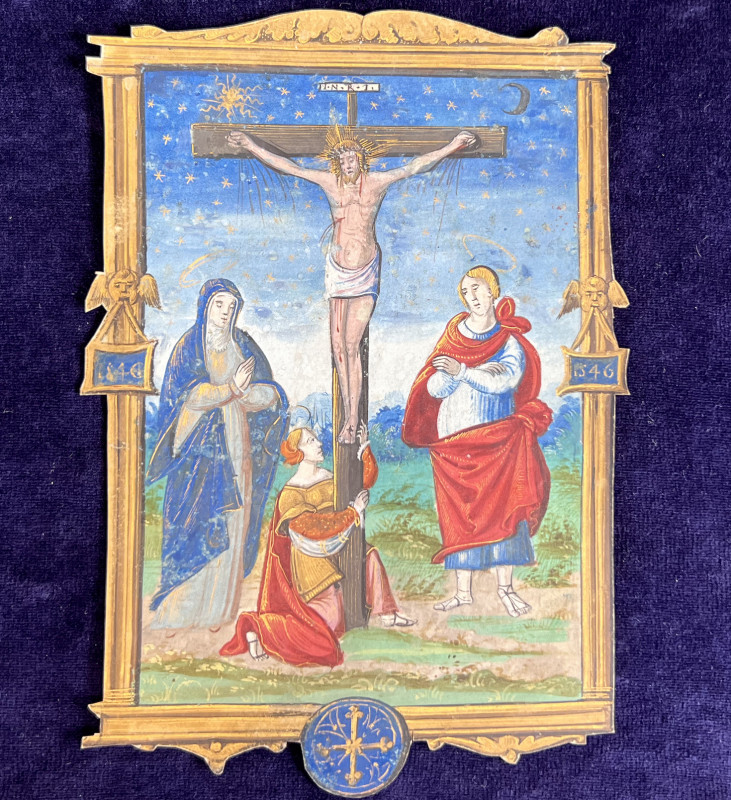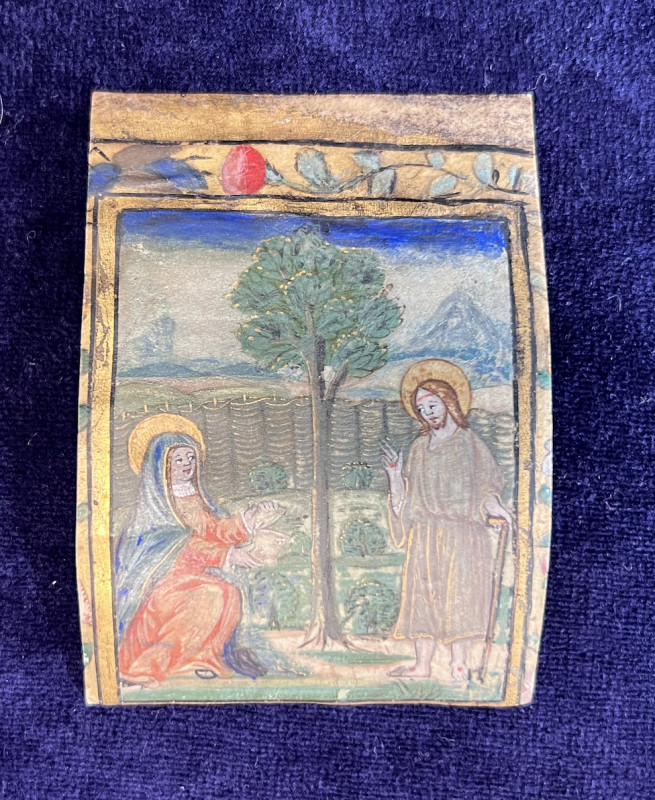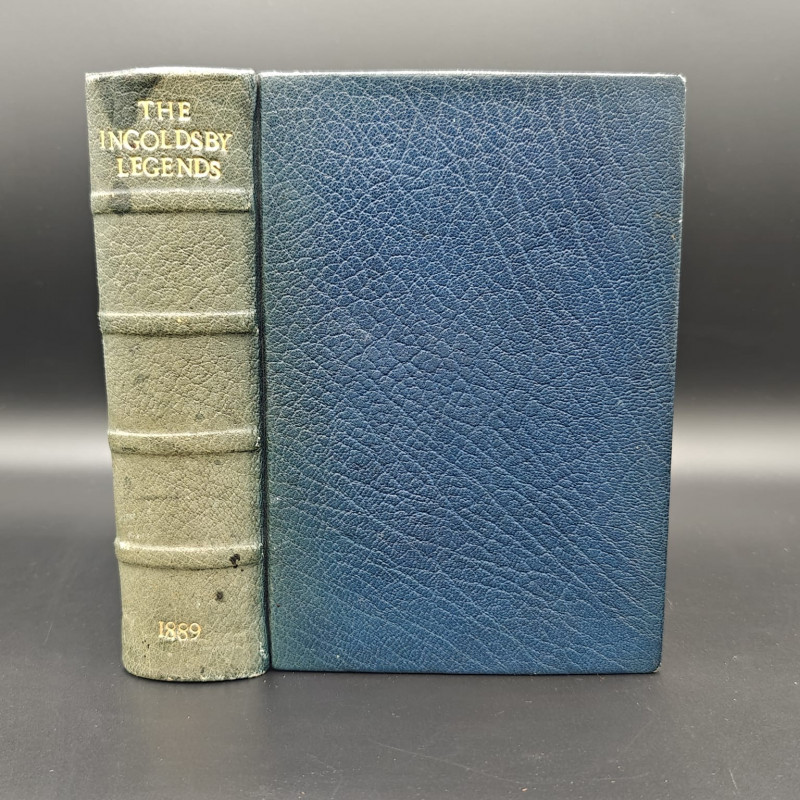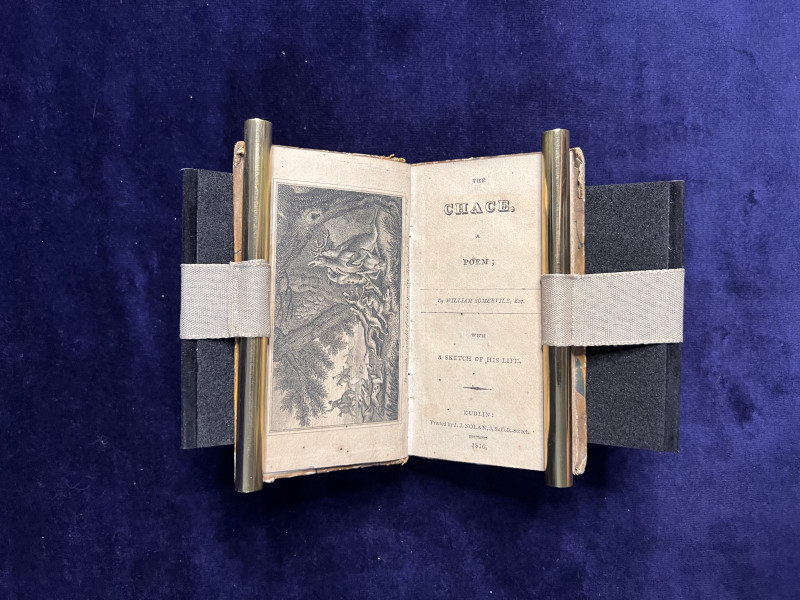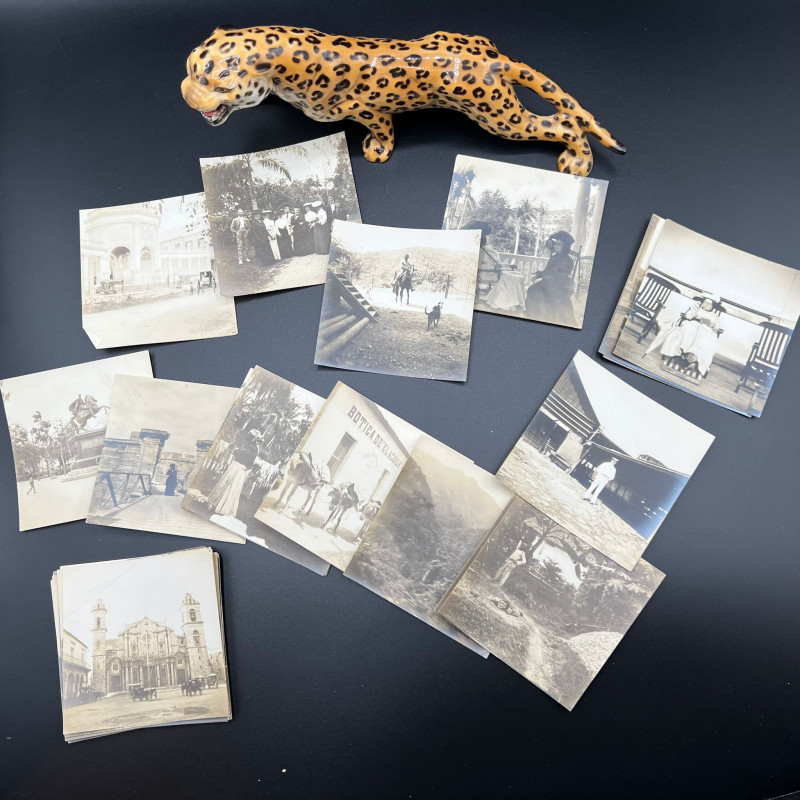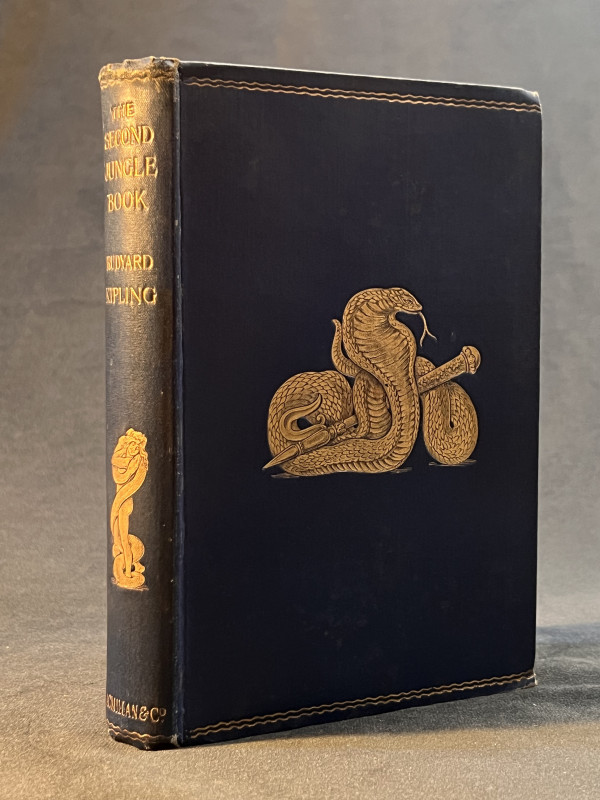Cosmographia
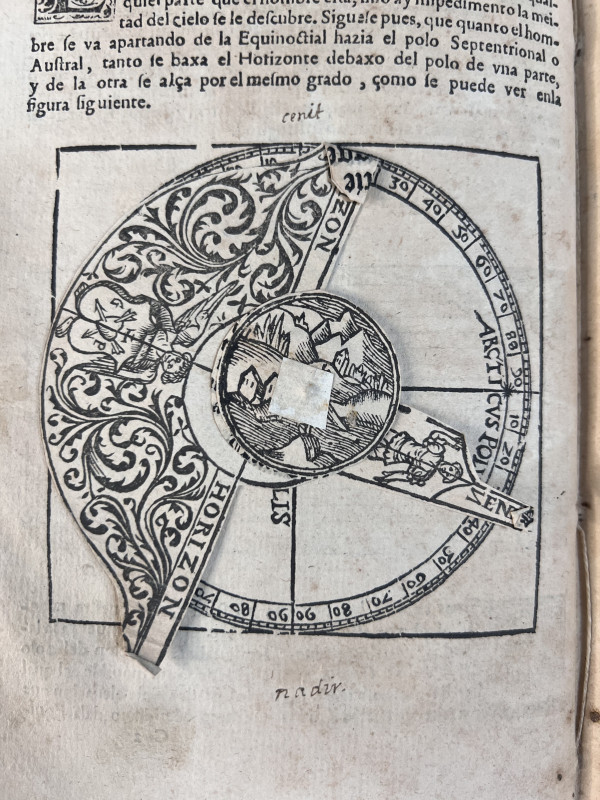





Book Description
APIAN, Peter. La Cosmographia de Pedro Apiano, corregida y añadida por Gemma Frisio, Medico y Mathematico. La manera de descrivir y situar los Lugares, con el uso del Anillo Astronomico, del mismo Auctor Gemma Frisio. El sitio y descripcion de las Indias y Mundo Nuevo, sacada de la Historia de Francisco Lopez de Gomara, y de la cosmographia de Ieronymo Girava Tarragonez. En Anvers. Por Juan Bellero al Aguila de Oro. Con privilegio de su M. D.LXXV. [1575].
Second Spanish edition. (235 x 170) ff [2], 68, [14] . Contemporary or near contemporary limp vellum binding with manuscript title and date on spine. Some ca. 17th c. binding waste from La vita di Maria Vergine imperatrice by Lucrezia Marinelli. Early owner’s notation in front and back of binding. Two lead clasps and string fasteners original to binding. Embellished with woodcuts and 5 volvelles (4 with moveable parts) to verso of folios 8, 11, 53 and recto of 30 (lacks moveable part, but moveable part not present in digital comperables). String constitutes moveable part on fol. 9v. Historiated and inhabited initials throughout. Globe woodcut on title page. Signature: A-I⁴ L-Y⁴
Lacks double-paged map (K signature). As noted above, one volvelle is lacking moving parts. Cracking of vellum on spine. Browning on final several pages. Minor spotting throughout expected with age. Binding held loosely by end band sewing stations (acts more as a wrapper).
Palau 13809; Sabin 1756; Alden 575/2; Peeters-Fontainas 62; Shirley 96; LeClerc Bibliotheca Americana 39; Van Ortroy 55.
Dealer Notes
The important second Spanish edition of the Cosmographia by Petrus Apianus (1495-1552)— handbook to (armchair) explorers and textbook to Renaissance scholars.
The German Peter Bienewitz, better known by his Latinized name Peterus Apianus, supplied the European audience, thirsty for knowledge about the New World and the methods of navigation propelling the Age of Exploration, with what they wanted. The work became so popular it was translated, originally, into three vernacular languages (Spanish, French, and Dutch) and later into a total of 14 languages with 45 editions produced. Why was the work so popular? A powerful combination of details about the New World and the ability to put the tools of exploration into the hands of the reader.
Originally published in 1524 (and in the scientific language of Latin), Apianus’ first masterwork, “Cosmographicus Liber,” provided readers with an understanding of cosmography (that which concerns the heavens) and geography (that which concerns the earth). The work provides theoretical explanations of longitude, latitude, the Zodiac, the movement of planets and stars, and time. It also provides the means to practically solve these problems by way of calculations and use of the moving paper instruments based on Ptolemaic principals— the famous volvelles, also called Apian Wheels. While Ptolemy’s works had been used since the Medieval period by way of Arabic translation and preservation of the text during a time when Greek literacy was uncommon in the West (see here for an example of 13th century Ptolemy text), Peter Apian’s wheels made the theoretical practical.
This copy is the second edition (1575) of only two Spanish editions. The first edition (1574) lacks the excerpts from Francisco Lopez de Gomara and Jeronimo Girava, as well as the description of Iceland. The editor, Gemma Frisius, was Apian’s student and he built upon geographical techniques, proposingg topographical triangulation, a new method of locating and mapping places which was only replaced in the 1980s by Global Positioning Systems (GPS)
The work begins with a defence of translating it into Spanish which to some, the preface notes, will seem useless and a vain curiosity; they will pretend that the science is diminished by pouring it into a vulgar language and making it public to all.
Part One, which includes three volvelles, explains theoretical aspects of measurement, astronomy, and cosmography, as well as giving the reader the technical instruments to solve these problems.
Part Two shifts to geography, describing Europe, Asia, Africa, and America. Here, the reader is told that America “tomo nombre de Americo Vespucio inventor della, y casi se podia llamar isla, por que la mar la rodea casi por todas partes” [took its name from Americo Vespucci, the one who found it, and it could almost be called an island because the sea surrounds it almost on all sides]. Additional details from the works of Doctor Francisco Lopez de Gomara and Señor Ieronymo Girava Tarragonez situate and describe “Las Indias o Mundo nuevo”, including the Yucatan, Florida, Peru, and Cuba. Famous expeditions, such as that of Christopher Columbus in 1492, Ferdinand Magellan, Ponce de Leon, and Hernando Cortes are described in varying detail.
The marks of provenance on this book speak to its circulation within Europe. The booklife begins in Antwerp in 1575. Examination of the moving parts of the volvelles reveals they are reenforced with printer’s waste— the ca. 1550s Dutch translation of Praxis rerum criminalium (De practijke of gebruyk zoo van civile als criminele zaken) by Joos de Damhouder (1507-1581). This work found particular importance in the contemporary witch trials. One of the sections which appears on the back of the volvelle on 8v states that “crimes, then, are to be punished so that the punishment of one may be the fear of many.” A chilling statement of civil law. The book’s life takes it to two more language spheres. Although there is very little marginal annotation, what is present is in Spanish, noting “los tropicos cancros y capricorno”, coupled with the notes on the terminal fly leaf with the legible “Los Hombres Notales”, followed by six lines of 16th century script, and the curious inscription of “Almoradux,” the transliterated arabic word for the spice marjoram. While the book likely stayed in Spain until the present day, the binding waste pasted to the flyleaves comes from the ca. 17th century Italian language text of Lucrezia Marinelli’s life of the Virgin Mary (originally published in 1602).
The German Peter Bienewitz, better known by his Latinized name Peterus Apianus, supplied the European audience, thirsty for knowledge about the New World and the methods of navigation propelling the Age of Exploration, with what they wanted. The work became so popular it was translated, originally, into three vernacular languages (Spanish, French, and Dutch) and later into a total of 14 languages with 45 editions produced. Why was the work so popular? A powerful combination of details about the New World and the ability to put the tools of exploration into the hands of the reader.
Originally published in 1524 (and in the scientific language of Latin), Apianus’ first masterwork, “Cosmographicus Liber,” provided readers with an understanding of cosmography (that which concerns the heavens) and geography (that which concerns the earth). The work provides theoretical explanations of longitude, latitude, the Zodiac, the movement of planets and stars, and time. It also provides the means to practically solve these problems by way of calculations and use of the moving paper instruments based on Ptolemaic principals— the famous volvelles, also called Apian Wheels. While Ptolemy’s works had been used since the Medieval period by way of Arabic translation and preservation of the text during a time when Greek literacy was uncommon in the West (see here for an example of 13th century Ptolemy text), Peter Apian’s wheels made the theoretical practical.
This copy is the second edition (1575) of only two Spanish editions. The first edition (1574) lacks the excerpts from Francisco Lopez de Gomara and Jeronimo Girava, as well as the description of Iceland. The editor, Gemma Frisius, was Apian’s student and he built upon geographical techniques, proposingg topographical triangulation, a new method of locating and mapping places which was only replaced in the 1980s by Global Positioning Systems (GPS)
The work begins with a defence of translating it into Spanish which to some, the preface notes, will seem useless and a vain curiosity; they will pretend that the science is diminished by pouring it into a vulgar language and making it public to all.
Part One, which includes three volvelles, explains theoretical aspects of measurement, astronomy, and cosmography, as well as giving the reader the technical instruments to solve these problems.
Part Two shifts to geography, describing Europe, Asia, Africa, and America. Here, the reader is told that America “tomo nombre de Americo Vespucio inventor della, y casi se podia llamar isla, por que la mar la rodea casi por todas partes” [took its name from Americo Vespucci, the one who found it, and it could almost be called an island because the sea surrounds it almost on all sides]. Additional details from the works of Doctor Francisco Lopez de Gomara and Señor Ieronymo Girava Tarragonez situate and describe “Las Indias o Mundo nuevo”, including the Yucatan, Florida, Peru, and Cuba. Famous expeditions, such as that of Christopher Columbus in 1492, Ferdinand Magellan, Ponce de Leon, and Hernando Cortes are described in varying detail.
The marks of provenance on this book speak to its circulation within Europe. The booklife begins in Antwerp in 1575. Examination of the moving parts of the volvelles reveals they are reenforced with printer’s waste— the ca. 1550s Dutch translation of Praxis rerum criminalium (De practijke of gebruyk zoo van civile als criminele zaken) by Joos de Damhouder (1507-1581). This work found particular importance in the contemporary witch trials. One of the sections which appears on the back of the volvelle on 8v states that “crimes, then, are to be punished so that the punishment of one may be the fear of many.” A chilling statement of civil law. The book’s life takes it to two more language spheres. Although there is very little marginal annotation, what is present is in Spanish, noting “los tropicos cancros y capricorno”, coupled with the notes on the terminal fly leaf with the legible “Los Hombres Notales”, followed by six lines of 16th century script, and the curious inscription of “Almoradux,” the transliterated arabic word for the spice marjoram. While the book likely stayed in Spain until the present day, the binding waste pasted to the flyleaves comes from the ca. 17th century Italian language text of Lucrezia Marinelli’s life of the Virgin Mary (originally published in 1602).
Author
1575
Date
1575
Binding
Contemporary or very near contemporary limp vellum
Publisher
En Anvers. Por Juan Bellero al Aguila de Oro
Condition
Good
Pages
ff. [2], 68, [14]
Friends of the PBFA
For £10 get free entry to our fairs, updates from the PBFA and more.
Please email info@pbfa.org for more information

